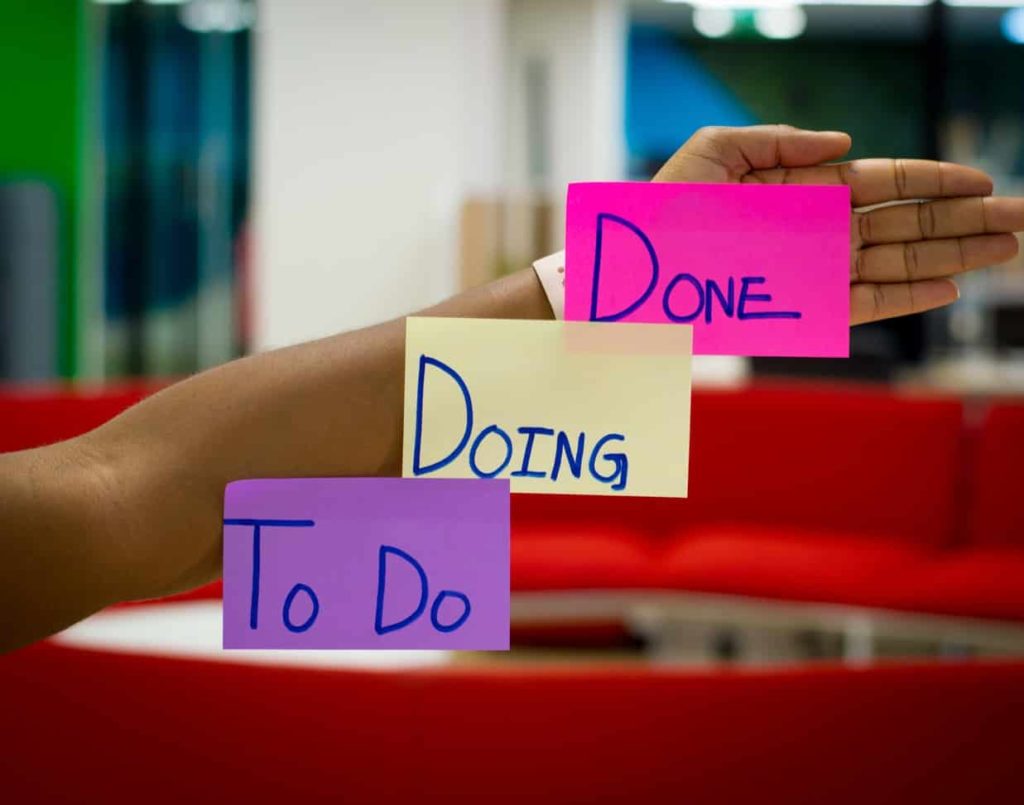
More than one year after its official declaration, Covid-19 is still forcing change upon organisations worldwide.
A large number of businesses are struggling to cope with rapid changes to supply chains.
However, you may also see various opportunities in the current socio-economic landscape. Some companies have taken advantage of these opportunities and adjusted their products, pricing and business models to gain market share and permanently lower their costs.
Therefore, driving project outcomes is essential to adapt to Covid-19 disruption and emerge with a sustainable competitive advantage.
Otherwise, organisations risk wasting billions of dollars when failing to deliver on expected outcomes, indicating a big disconnect between intentions and meaningful execution.
You might also reflect that if you don’t seize opportunities, your competitors may do it. And to seize opportunities and make change happen, you need a project (a series of actions taken by a team to achieve defined objectives).
Nevertheless, in the current environment, some organisations have the right ideas and strategies, but they fail to follow through and deliver that change and the business outcomes they need. In this case, they may have a problem with execution.
At the same time, other businesses are executing very well and reaping the benefits by delivering the required objectives and required business outcomes.
So, what are these companies that have delivered the expected outcomes doing differently from their peers? What are the key practices that allow these organisations to continue delivering the changes required to survive and even thrive despite the challenges posed by Covid-19?
This article will describe 5 practical techniques you can use to continue to deliver real business outcomes despite the challenges posed by the current global pandemic. These practices are able to produce significant results and make the difference between project success and failure.
Also, the key practices listed in this article will benefit any sized project, from very small businesses initiatives right through to major projects, allowing organisations to continue delivering the vital changes they need to survive and even thrive in the modern age.
Table of contents:
- Realistic planning
- Disciplined execution
- Project leadership and team management
- Widespread effective stakeholder and change management
- Simple integrated technology platform
1. Realistic Planning

The first practice you need to follow to drive project success is realistic planning.
Funnily enough, many organisations do not actually have an effective plan, although everyone knows the importance of having one to achieve anything even slightly complicated.
Maybe their initial plan it’s no longer current, whereas what is needed in all cases is a realistic plan that the team is reasonably confident of achieving.
A quantified business case is an essential prerequisite for effective planning as it clarifies what the project is trying to achieve and why the project deserved funding in the first place. Trying to plan a project without a quantified business case is like trying to plan a route to an unknown destination.
Armed with the business case, you can then develop a realistic plan to define:
- Schedule (which is your typical Gantt chart that shows the dependency relationships between activities and the current schedule status)
- Costs (your budget)
- People and materials (your resource plan)
- Benefits realisation (which is often forgotten)
The key to creating a realistic plan is actually to keep it simple. Sometimes, projects are way too complicated – they include hundreds or even thousands of details to specify what happens each day.
This is the main reason why you need a Gantt chart to indicate your one to two-week tasks and major dependencies (that’s another area where sometimes organisations can get too complicated by trying to mark every predecessor and every successor). So, to keep your project plan simple, you should mark only the major dependencies.
However, it would be best if you also remembered that very true saying that none of us has a crystal ball (particularly in the current environment where changes occur within a short time frame).
Therefore, the only way you can cater for that uncertainty is to make sure that when you’re planning, you have on the team helping you with these plans, whether it’s a minor capital project or a systems implementation or digital transformation.
In the earlier upcoming periods for which you’re planning (e.g., the next three to six months), you can put more details in your plan because you have a higher degree of uncertainty.
But leaving your plan at one or two month level of details is just fine. As those times get closer, your certainty about what will actually be required starts to increase and then you can decompose the plan into something more detailed.
However, it would be best not to go beyond that one to a two-week level previously recommended.
2. Disciplined Execution
Once you have a good, feasible plan and the team is confident in executing it, you need to instil a disciplined execution.
In other words, “you’ve planned the work, now you have to work the plan”.
Disciplined execution can be divided into five major areas:
1. Variation management
Variation management is a simple process that can be implemented on a weekly basis according to the following model:
- Update your actuals.
- Rely on an early warning system (as soon as there’s a variation from what was planned, it sets off an alert to leadership).
- Develop a simple recovery plan meaning a series of actions you’re going to take to get back onto the plan. For example, suppose you have in your Gantt-Chart a task that’s going to take two weeks and then at the end of the first week, someone updated the actuals and said you’re only 25% complete. That indicates a variation and triggers an alert. As a result, you respond to that by developing a recovery plan.
- Look at the different options you have in your recovery plan. The most common option organisations have is to involve more resourcing. This option can work and be quite effective. But more often than not, there are many other good options you can use that don’t have additional costs and can be even more effective.
- See the project developing a very orderly operating rhythm (the simple process of working the plan, detecting variations and recovery plans, getting back on track and repeating).
Once you implement variation management, you will observe your project sticking to the plan. Of course, your project may have some ups and downs. However, it will stick to the plan and deliver the desired outcomes.
2. Risk management
The next most important discipline after variation management is risk management. Risk management has a very bad reputation as it’s commonly regarded as something boring and bureaucratic.
However, the basics of risk management are simple. You only need to look ahead, anticipate what can go wrong, and don’t let anything go wrong. This simple discipline is very commonly overlooked. Nevertheless, if you put it in place as part of your regular weekly cadence, you will benefit from it.
3. Reporting
Reporting is another issue that can make projects run into trouble. A lot of effort each week can produce too much reporting and complexity and too many metrics (and having too many metrics can be as bad as having none).
When it comes to good reporting, there are two key elements you need to consider:
A. Good reporting surfaces only those key metrics that determine the project’s ability to achieve its outcomes. You should always use five simple metrics for measuring variations from:
- Plan
- Schedule
- Cost
- Benefits delivery
- The risk and issue profile of the project
B. Reporting must be credible as typically there is a lack of trust in status reports and a suspicion that bad news is actually being hidden.
4. Re-baselining
Another common failure point on projects is when teams have a good plan at the start, but they fail to keep it current to a large number of small and seemingly minor changes. Increasingly, teams are working on activities that are not on the plan.
As time goes on, the plan becomes less and less relevant and no longer referred to as the guide to weekly activities. So, a project, in that case, doesn’t actually have a plan. As a result, organisations lose sight of the sequence of activities that should get them to the outcomes.
5. Benefits realisation
Finally, no. 5 discipline for effective execution is benefits realisation. It’s essential to realise and remember how you obtain funding for the project right at the start in the quantified business case, which promises specific outcomes. Then, you have to create a plan on the timing by which these benefits would be realised.
For example, consider scope change requests instead of evaluating just the budget and the cost impact. You may decide to approve a high-cost increase because it actually increases the business benefits even higher. One hundred thousand dollar scope increase can bring you a half a million dollar increase in benefits.
This is an example of how you can incorporate the benefits realisation into your day to day decision making and then track at the end to make sure those benefits are realised without allowing the project to close until they have actually been realised.
3. Project Leadership and Team Management

The third key practice that makes a difference between successful and failed projects is effective leadership and team management.
There are three key elements you need to consider for effective leadership:
1. Team morale
A key element of effective leadership is protecting team morale. The best way to do that is to make sure it’s a well-run project where you’ve instilled the disciplined execution previously mentioned.
When the team sees a realistic plan in place, and they observe themselves sticking to that plan, it increases the team’s confidence. As a result, they believe in the project’s outcomes and get confident and excited about their ability to achieve them, which is great for morale and productivity.
2. Staffing decisions
The other important part of leadership on projects is your staffing decisions. People focus too much on getting the right domain expertise. For example, if it’s a technology project, they’re getting the right technical skills.
Domain expertise is important, but you also need to make sure you get on board the people with the right skills and personalities for projects (because many experts don’t work well on teams and projects).
What you need from project personalities are self-directed and proactive people who work well to time, focus on outcomes, and, most importantly, resolve differences in opinion constructively and always treat their colleagues with respect. You don’t want the conflict-prone, hostile type people on projects that can ruin the atmosphere and the productivity.
3. Active mutual support
Great project managers also work very hard to establish the right atmosphere on the project.
Therefore, you have to create an atmosphere of active mutual support, where each team member productively meets their own accountabilities but actively looks for ways to support their colleagues – as opposed to active warfare which involves confusion, disorder, and infighting.
4. Widespread Effective Stakeholder and Change Management
Establishing widespread, effective stakeholder and change management is a very important practice for successful projects. You can do it by:
- Having one-on-one conversations
The most effective change management normally happens through one-on-one conversations in a trusted environment.
You can get nuggets out of those conversations that you would never get from surveys and broad-brush approaches.
- Maintaining confidence through in control execution
Maintaining confidence through in control execution not only helps you with good morale for the team but also with your stakeholders (particularly senior stakeholders). Sometimes, projects don’t focus on what they are actually projecting to the external world. It may be chaos internally, and the external world sees it as chaos as well. Senior stakeholders are very much able to identify the signs of an out of control project.
On the positive side, if it’s a well-run project, senior stakeholders observe that and get increasing confidence in the team’s ability to achieve the outcomes.
To keep the confidence, you really need to run the project well and make sure that’s what’s you’re projecting. Sometimes, extra stakeholder attention can actually create more problems in their attempts to help as it can create a lot of extra reporting and requests. As a result, you can end up spending more time talking about it than actually doing it, which makes the problem actually worse.
- Creating transparency
Effective stakeholder management requires full and open transparency and objectivity because that’s what senior stakeholders need to help and guide the project. If an executive doesn’t know about an issue or if there’s some bad news they don’t know, they can’t help resolve it.
This is the brutal reality that senior stakeholders are experts at spotting when something just doesn’t smell right, so they know when they’ve been gamed.
This situation can lead to a lack of trust and negative consequences like those previously mentioned (e.g., requests for additional reporting).
5. Simple Integrated Technology Platform

To implement many of the practices mentioned in this article, you need a supporting software platform.
Otherwise, you can end up with that situation called “standards on a shelf”, where everyone has all the right ideas about good standards, procedures, governance and project managers. However, these ideas are just written in a nice word document that sits on a shelf, and it’s not widely referred to, so it’s essentially valueless.
Therefore, to help you embed your good ideas and support all the types of good practices outlined in this article, you need a technology platform that supports them.
A top-notch software platform is designed to support:
- Realistic planning
- Disciplined execution best practices (including variation management, the early warning system, etc.)
- Benefits realisation
- Transparency
- Tailored governance (tailored governance is an important topic as it can be a problem when organisations try to take very large project standards, procedures, methods, requirements and apply those to small or medium-sized projects)
Also, the technology platform you use should be secure and cloud-based, particularly in the modern world. With everyone working from home, you need a platform that people can access anytime and anywhere. All you need is a browser and a network connection.
It may sound a little bit sarcastic, but the most dominant project management platforms out there are actually Microsoft Excel and PowerPoint. Many organisations are still running large parts of their projects through those two pieces of software.
Microsoft Excel and PowerPoint are great software, but we can certainly do a lot better when it comes to project management, portfolio management and benefits realisation (for this reason, we invite you to visit our website and learn more about Focus HQ, a portfolio management platform that predicts, automates and guides all of your projects to success).

Conclusion:
The practices mentioned above are five simple practices to successfully deliver business outcomes from your project: realistic planning, disciplined execution, effective project leadership and team management, widespread stakeholder and change management, and utilising a simple integrated technology platform.
If you’re able to follow these recommendations and implement these across all your projects in a consistent manner, you are likely to achieve significant results.
All of these techniques are possible and important in the current environment because organisations really need these changes to happen. They need first-class project management to turn their ideas into reality.
If you want your project to have a greater chance of success and drive desired outcomes in the “new normal”, do not hesitate to contact us or schedule a session to demonstrate the benefits we can provide to your organisation. Focus HQ would be glad to provide you with the tools, methodology and intuitive knowledge to significantly increase performance for your projects!




























